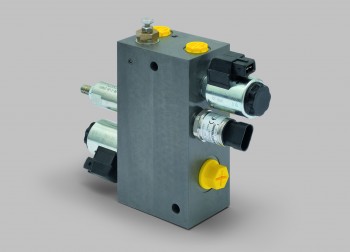Linde Hydraulics Reveals Hydraulics System With Additional Energy-Saving Function
Start-stop system saves fuel and reduces noise generation in agricultural machines

The start-stop valve controls the loading and unloading of the hydraulic accumulator. Both components can be freely positioned in the machine, individually or assembled.
Photo by Linde Material Handling GmbH
- Purely hydraulic system
- Cost-effective solution
- Simple integration into the drivetrain
- Energy savings every time you stop work
- CO2 reduction
- Boost function possible
- Noise reduction
In automotive engineering, the automated start-stop system has become a standard feature in all energy-saving vehicles. According to manufacturers, 2 to 6% of fuel can be saved when the engine is automatically switched off at traffic lights or in traffic jams – depending on the driving cycle.
The savings are significantly greater for agricultural machines, because these machines are often operated on an intermittent basis. When the diesel engine is continually running, this not only results in unnecessary fuel consumption but also increases the noise level on building sites.
Linde Hydraulics has been examining this issue in great detail, investigating ways that diesel engines can be switched off and restarted in line with demand in agricultural machines such as wheel loaders, for example. The solution – a new type of hydraulic start-stop system – will be showcased at Agritechnica trade fair.
The basis of the automated start-stop system is the electrically controlled medium-pressure pump, MPR 50, which works as a system component to supply oil to the hydraulic work functions. The pump has also now taken on an additional task: When the diesel engine is in operation, the pump charges a compact hydraulic accumulator. When the Linde Hydraulics electronic control unit LINC detects that the driving and working functions have come to a standstill, the internal combustion engine is switched off. When the operator touches the pedal or moves the steering wheel or joystick, power is fed from the accumulator via a valve block back to the MPR pump, which then functions as a starter motor. The diesel engine then ramps up to a pre-set engine speed. This starting procedure is four times quicker than starting using an electric starter motor, ensuring that the machine is ready for operation without any noticeable delay.
At Agritechnica, Linde Hydraulics will not only be presenting the start-stop system concept, but also the consumption savings that have already been measured in a fork-lift truck. The calculation is very simple. On the one hand, there is the rise in consumption caused by the active charging of the accumulator that, using the control system, can be linked for example to a lifting operation with an increase in engine speed. On the other hand, the consumption of the diesel engine when idling needs to be considered when calculating the efficiency. When examining the relationship between these two factors, the result is as follows: After just 2.5 seconds, the consumption advantage gained by switching off the internal combustion engine is greater than the energy required to start it.
The extent of the consumption advantage is in practice, of course, highly dependent on the type of agricultural machine and also on individual usage and the duration of work stoppages. Since the system is very compact and the hydraulic accumulator and the start-stop valve block can be freely positioned, agricultural machines with hydraulic working functions can be equipped with a start-stop function – or not – as required, without the need for any design modifications.
As well as saving energy and reducing exhaust emissions, the start-stop function has the additional advantage of reducing noise. In addition to telehandlers, Linde Hydraulics can see the start-stop system being used in telehandlers and other agricultural machines with intermittent working patterns.
For more information, go to http://www.linde-hydraulics.com/
News Categories
- » NEWS HOME
- » Automation & Robotics
- » Industry 4.0
- » Material Handling
- » Sensors
- » Quality & Testing
- » Machine Vision
- » Laser & Optics
- » Metalworking
- » Motion Control & Drives
- » Hydraulics & Pneumatics
- » Process Industry
- » Renewable Energy
- » Agriculture
- » Home & Office Furniture
- » Environmental Tech


